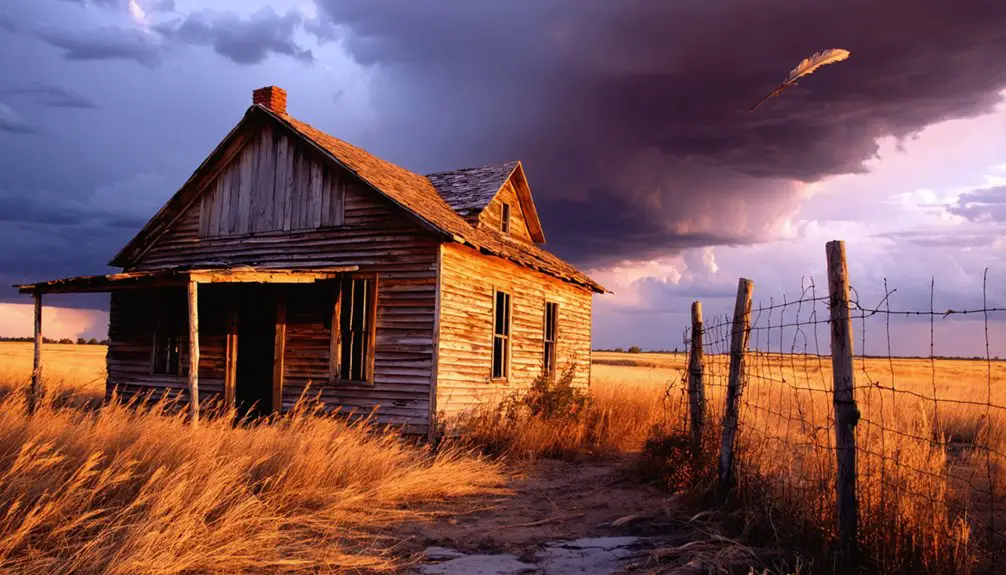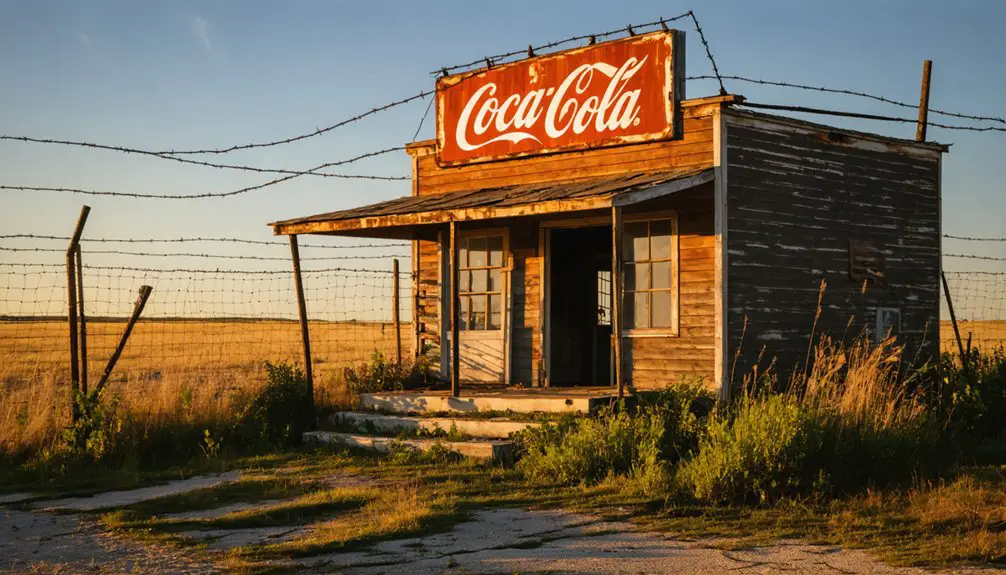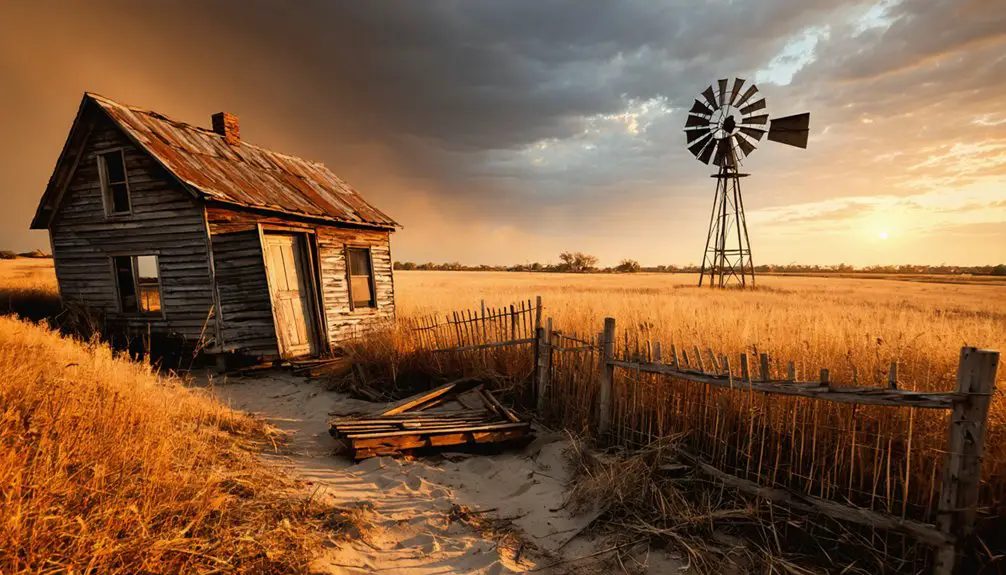You’ll find Cloud Chief, Oklahoma’s fascinating transformation from a bustling frontier town to a haunting ghost town in Washita County. Originally named Tacola, it emerged during the 1892 Cheyenne-Arapaho land rush, quickly growing to 3,000 settlers with 50 businesses. After losing its county seat status to Cordell in 1900, the once-thriving community declined dramatically. Today, you can explore the abandoned schoolhouse and original building remnants, where territorial history whispers through the prairie winds.
Key Takeaways
- Cloud Chief was established in 1892 during the Oklahoma land rush, initially growing to over 3,000 residents as a county seat.
- The town declined after losing its county seat status to Cordell in 1900, leading to population loss and abandoned buildings.
- The abandoned schoolhouse, closed in 1960, remains the most prominent structure in Cloud Chief’s ghost town landscape.
- Originally named Tacola, the town once boasted 50 businesses serving settlers before its eventual decline into ghost town status.
- Metal detecting enthusiasts now explore the ghost town’s grounds for historical artifacts from its territorial period.
From Tacola to Cloud Chief: The Birth of a Frontier Town
When the U.S. Congress opened the Cheyenne-Arapaho reservation lands in 1892, you’d have witnessed the birth of a frontier town that would shape Oklahoma Territory’s early days.
The Tacola origins began in April when surveyors platted the townsite, laying out streets and lots before the land rush commenced. You’d have seen over 3,000 settlers flood the area, with a second race at 1 PM specifically for the 320-acre townsite.
Within hours, you’d have found yourself amid a bustling tent city where 50 businesses sprouted up, including saloons and grocery stores. However, this prosperity was short-lived as lack of transportation led to the town’s eventual decline. To avoid confusion with similar names, settlers used internal linking practices to distinguish their new community from other settlements.
The Cloud Chief history took root when the town’s name changed from Tacola shortly after its establishment, and as the designated county seat of H County, it quickly became an essential administrative center.
The Great Land Rush and Early Settlement Days
When you stand at Cloud Chief’s former site today, you’re walking where settlers rushed in during Oklahoma’s historic 1889 land run, joining the chaotic race of 50,000 people competing for 1.9 million acres of Unassigned Lands.
The town grew amid a dramatic population surge that saw Oklahoma Territory’s residents increase from 258,657 in 1890 to over 1.4 million by statehood in 1907.
As claims were staked and disputes erupted between settlers, you would’ve witnessed the intense competition marked by the period’s famous slogan “160 acres or six feet, and I don’t give a damn which.” Settlers had to prove their dedication by maintaining five years of residence on their claimed land before receiving official title.
The earliest residents quickly transformed their claims into a functioning town, using horses and wagons to haul building materials while establishing essential services amid the challenging frontier conditions.
Rush to Cloud Chief
The Great Land Rush of April 22, 1889, brought thousands of hopeful settlers to Oklahoma’s Unassigned Lands, transforming the region’s frontier landscape virtually overnight.
You’d have seen settlers rushing to Cloud Chief using every means available – horses, wagons, and even on foot. Like other settlement areas, Cloud Chief’s pioneer life emerged from a mix of Boomers and Sooners staking their claims amidst the chaos. With the absence of liquor, settlers managed to avoid bloodshed despite intense competition for prime lots. Soldiers at the starting line maintained order as participants awaited the boom of the cannon to begin their race for land.
Settlement dynamics proved challenging as you’d have found yourself competing with others to mark lots using sticks and tents, while constantly guarding against claim jumpers.
The community challenges were immediate: poorly planned streets, insufficient infrastructure, and disputes over property lines.
You’d have witnessed the rapid transformation from tent city to established townsite as settlers sought to build a permanent presence along vital transportation routes.
Land Claim Disputes Emerge
Despite government raids and forced expulsions lasting until 1884, settlers persistently pushed into Indian reservation lands around Cloud Chief, creating a complex web of legal disputes.
The U.S. Cavalry kept order at picket lines as anxious settlers gathered the day before the rush. You’d find early settlers hiding in the territory before official start times, waiting to stake their claims. When disputes arose, local committees handled dispute resolution through swift, sometimes harsh justice. Claim jumpers who seized others’ land faced severe punishment, even death in extreme cases.
The chaotic rush began with a noon gunshot signal, as tens of thousands of settlers raced to claim their piece of land.
The chaos intensified as deputy U.S. marshals claimed prime lots for official use, forcing you to settle for less desirable parcels. After the 1890 Organic Act, government land offices finally brought formal structure to the claims process, replacing the informal committees.
However, you’d still need government surveyors to correct any self-surveyed property lines.
Settlers Build Their Dreams
As dawn broke on April 22, 1889, nearly 50,000 enthusiastic settlers converged on Oklahoma’s Unassigned Lands, marking a dramatic shift from earlier territorial disputes to organized settlement.
You’d find settlers from all walks of life – farmers, cowboys, veterans, and entrepreneurs – working together to build their dreams on 160-acre plots.
They’ve quickly established communities, helping each other ford rivers and raise buildings. Dream building wasn’t just about individual homesteads; it was about creating a shared future. The Santa Fe Railroad construction in 1887-1888 helped fuel the momentum of settlement in the territory.
Community resilience showed in how settlers formed local governments, schools, and churches while maintaining frontier traditions.
In places like Guthrie and Oklahoma City, you’ll see how populations swelled to 10,000 by nightfall, as people joined forces to create vibrant new communities from the untamed prairie, their pioneering spirit evident in every nail driven and field plowed. Following years of unauthorized settlement attempts by determined Boomer activists, the official opening of these lands represented a long-awaited opportunity for legal homesteading.
Building a Thriving Community in Oklahoma Territory
As you look back at Oklahoma Territory‘s rapid transformation after the 1889 Land Rush, you’ll find communities like Cloud Chief emerging from initial tent settlements into organized towns with permanent structures and businesses.
In the early 1890s, these territorial settlements grew through a mix of homesteaders establishing farms and merchants opening essential services like general stores, blacksmith shops, and grain mills.
You’d have witnessed the territory’s population explode from 78,475 in 1890 to nearly 400,000 by 1900, as settlers established new roots and built interconnected agricultural communities.
Early Business Growth
The rapid establishment of Cloud Chief’s business district in 1892 transformed raw Oklahoma Territory into a bustling frontier town within weeks.
You’d have found a variety of business ventures springing up to serve the needs of over 3,000 initial settlers, from general stores to mercantile shops and barbershops.
Despite economic challenges when many settlers temporarily left to manage their previous affairs, the town’s commercial spirit endured.
By 1895, you could hear the buzz of William Haws’ sawmill along the Washita River, processing local cottonwood timber.
The town’s role as county seat brought a steady stream of government workers and visitors, supporting local merchants.
Within eight years, Cloud Chief had grown into a stable community of 700 residents, with businesses serving both townspeople and surrounding farmers.
Population Settlement Patterns
Prior to Oklahoma Territory’s formal establishment in 1889, diverse indigenous peoples had developed sophisticated settlement patterns across the region, from the agricultural Wichita villages along river terraces to nomadic Comanche camps on the plains.
As settler demographics shifted during the 1890s land runs, you’d have found a mix of southern migrants, freedmen, and others establishing new lives in the challenging frontier environment. Many newcomers initially built dugouts or sod houses while attempting to cultivate crops in the harsh conditions.
Early agricultural practices often failed, forcing families to rely on turnips and other hardy vegetables for survival. You would’ve seen communities form through mutual support networks, with rural schools serving multiple functions as churches and social centers.
This cooperative spirit proved essential as settlers worked to transform the territory’s unassigned lands into viable homesteads.
Native American Heritage and Ghost Dance Legacy

Before white settlement transformed the region in 1892, Cloud Chief’s landscape belonged to Cheyenne and Arapaho peoples who maintained deep spiritual connections to the land through practices like the Ghost Dance ceremonies.
These sacred rituals represented Native American resilience in the face of cultural upheaval, expressing hope for a return to traditional ways of life as buffalo herds diminished and settlers encroached on tribal lands.
You’ll find evidence of cultural preservation in the area’s rich history, where John Seger established a colony of 120 Cheyenne and Arapaho farmers nearby.
Though federal policies pushed for assimilation through programs like the Seger Indian School, the tribes worked to maintain their identity.
Today, the ghost town’s location serves as a poignant reminder of the indigenous peoples who first called this land home.
The Loss of County Seat Status and Decline
Initially established as Tacola in 1892, Cloud Chief rapidly grew to over 3,000 residents after Congress designated it as Washita County‘s seat on former Cheyenne-Arapaho reservation land.
The population soon stabilized at around 700 as settlers managed their affairs elsewhere during the six-month settlement window.
You’ll find that Cloud Chief’s grip on county seat status weakened when western residents opposed traveling there for business.
Despite Congress’s original designation, locals voted in 1900 to move the seat to Cordell.
Though the Supreme Court initially voided this election, Congress made Cordell a co-county seat in 1906.
This decision triggered Cloud Chief’s civic decline, as businesses and settlers relocated to Cordell.
The town’s administrative importance faded, leading to abandoned buildings and eventual ghost town status.
What Remains: Modern-Day Ghost Town

Remnants of Cloud Chief‘s once-bustling streets now stand as weathered testimony to its past glory.
You’ll find just a handful of original buildings, with the old schoolhouse being the most prominent abandoned structure still intact since its closure in 1960. While some buildings serve as makeshift storage spaces, most are slowly surrendering to time’s relentless march.
If you’re interested in ghost town exploration, you’ll discover Cloud Chief’s remote location in Washita County has helped preserve what’s left of its historical footprint.
Metal detecting enthusiasts occasionally search the grounds, particularly near the school, for artifacts of bygone days. While no active community exists here today, the quiet ruins continue to draw visitors seeking connection to Oklahoma’s territorial past.
Exploring Historical Remnants and Artifacts
As you explore Cloud Chief’s historical landscape, you’ll discover a rich tapestry of artifacts dating back to its 1892 founding as Tacola, when over 3,000 settlers rushed to claim plots in the former Cheyenne-Arapaho Reservation.
The town’s cultural significance is evident in its well-preserved school buildings, crumbling downtown structures, and visible street layouts that tell the story of its rapid rise and decline.
Metal detecting enthusiasts can uncover relics around former public spaces, while foundations of the historic post office and local stores reveal the town’s economic heartbeat.
These remnants stand as silent witnesses to both the settler expansion and Native American heritage, including the spiritual Ghost Dances held before 1900.
Artifact preservation efforts help maintain these physical connections to Cloud Chief’s dynamic past.
Frequently Asked Questions
What Was the Average Cost of Land During Cloud Chief’s Initial Settlement?
You’ll find land prices during initial settlement were typically $1.25 to $2.50 per acre, following standard settlement patterns of Oklahoma Territory, though exact Cloud Chief costs aren’t conclusively documented.
Were There Any Natural Disasters That Contributed to Cloud Chief’s Decline?
Like a relentless tide, the 1930s Dust Bowl was the main natural calamity that hammered Cloud Chief. You’ll find its economic impact, combined with severe storms, contributed to the town’s gradual decline.
How Did Early Settlers Get Their Water Supply in Cloud Chief?
You’d have found your water from the nearby Washita River, Cloud Creek, and natural springs, while shallow wells tapped local aquifers. Simple ditches and small dams helped manage these water sources.
What Happened to the Original County Records After Relocation to Cordell?
You’ll find the county records were moved during a contentious nighttime operation, sparking gunfights. Most records landed safely in Cordell, though some offices temporarily maintained documents in both locations during the shift.
Were There Any Famous Outlaws or Lawmen Associated With Cloud Chief?
You won’t find any documented outlaw legends or significant lawman stories from Cloud Chief’s history. While the town had a basic jail and local enforcement, no notorious figures emerged from its frontier days.
References
- https://kids.kiddle.co/Cloud_Chief
- https://en.wikipedia.org/wiki/Cloud_Chief
- https://www.kaypratt.com/cloud-chief-oklahoma-ghost-town/
- https://www.youtube.com/watch?v=wSt3RYWLw2I
- https://okgenweb.net/~okwashit/history/cloud-chief1.htm
- https://www.islands.com/1870004/oklahoma-town-route-66-almost-abandoned-curious-historical-sites/
- https://mix941kmxj.com/here-is-the-sad-tragic-story-of-toxic-little-oklahoma-ghost-town/
- https://www.youtube.com/watch?v=gg3ICLT5OZY
- https://www.okhistory.org/publications/enc/entry?entry=LA014
- https://npshistory.com/publications/jeff/newsletters/museum-gazette/oklahoma-land-rush.pdf



